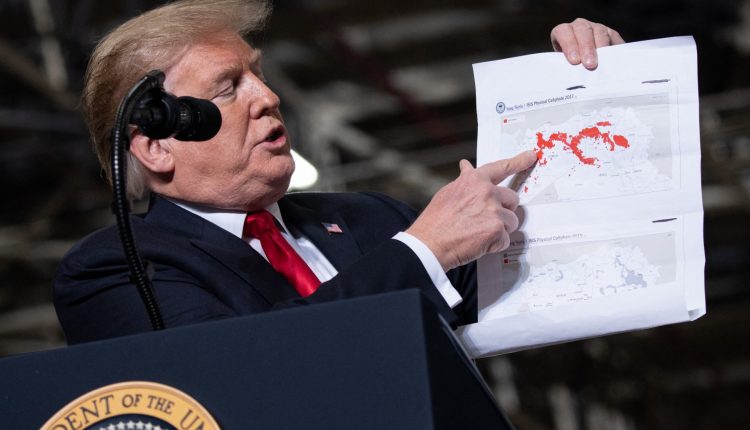Trump and Netanyahu’s Contributions to the ‘Syrian Issue’ and the ‘Eastern Question’
By Hussain Jummo
The directives from the U.S. Department of Defense for families of American soldiers and non-essential personnel to leave several Middle Eastern countries suggest the imminence of a new war. The outcome may not be known for days, but a new course is being charted in negotiations with Iran; one marked by significant preparations for war. But what does this scenario, whether war or merely the buildup to it, mean for Syria? It has become justifiable to describe Syria as the ‘Syrian issue’ within the latest and most unexpected version of the return of the ‘Eastern Question’ and the ‘Great Game,’ expanding to encompass the borders of the Eastern Question in the 19th century, from the Durand Line between Afghanistan and Pakistan to the Bosphorus.
If negotiations with Iran collapse and this is officially announced by U.S. President Donald Trump, then the Israeli vision will have triumphed the Trump way in Syria as well. Paradoxically, Syria remains connected to Iran, albeit in a manner opposite to what was typical during Assad’s era. This suggests, along the same lines, that the Israeli perspective will replace the American one, affecting internal arrangements among the various actors within Syria, as well as regional links to the rule in Damascus. It is well known that the contradiction between the two sides —Trump and Israeli Prime Minister Benjamin Netanyahu — became apparent mainly over the ‘Iranian issue’ and the ‘Syrian issue.’ The Trump administration was quick to accelerate and prioritize its Arab allies’ interests in Syria, granting the government of Syrian President Ahmad al-Sharaa full American authorization to consolidate his rule.
Trump’s new envoy to Syria, Tom Barrack, is addressing the Levantine awareness with a shabby and empty version of the ‘victim culture’ that has persisted amid the rubble of 150 years of mutual localised criminality in the Levant. In one of his recent statements, he expressed concern that al-Sharaa might be assassinated and claimed that the US aims for al-Sharaa to build a model of governance similar to what al-Jolani has established in Idlib. He then praised Trump’s virtues concerning Syria and addressed the ruling group (believing he was speaking to Syrians) by saying: “Do you want to build your nation? Go ahead!”
Since the meeting between Trump and al-Sharaa in Riyadh, Israel has internalized the US shift towards the new Damascus, as well as towards Lebanon and Gaza. Gradually but rapidly, it has dismantled Steve Witkoff’s efforts for a ceasefire in Gaza, resumed relentless bombing of Lebanon, and launched raids on Syria under the pretext that rockets were launched from there toward the Golan Heights. This indicates that Trump’s attempt to keep Israel out of the region’s reshaping, contrary to Netanyahu’s boasts, has failed, just as the bets of those who believed Israel’s priority was to reach a peace agreement with al-Sharaa.
Israel’s priority, according to its preemptive, offensive approach in Syria, is not defined by a peace treaty, nor is it to leave Syria to become a large armed force and a potential threat (theoretically, of course) at some future point. Therefore, peace is not the goal of the Netanyahu government. It is more likely that Netanyahu’s government does not want peace with Syria at all, because such an agreement would end its operations to control the level of power permitted to both Syria and Lebanon.
One of the indicators that support Israel’s efforts to disrupt the current US approach to the ‘Syrian issue’ is Trump’s shift to a defensive internal position in front of a Republican and Democratic bloc that perceives events differently than the ‘Make America Great Again’ team —this latter group having lost one of its most prominent symbols: Elon Musk. The billionaire’s departure from this circle is viewed as a sign that the group is on a downward slope.
For example, this week, during a Senate hearing, a deep and public rift within the Republican Party over policy towards Russia and the Ukraine war was revealed, highlighted by a verbal clash between Senator Mitch McConnell and Defense Secretary Pete Hegseth. This exposed a split between the traditional Republican establishment and the ‘America First’ wing.
McConnell, one of the most prominent Republican hawks, openly criticised the Trump administration and Hegseth, asserting that ‘America’s reputation is at stake’ in the battle against Russia.
The hearing uncovered a significant divide within the Republican Party: McConnell and Lindsey Graham represent the traditional, interventionist mainstream supporting allies, while Hegseth and Vice President J.D. Vance embody the more isolationist ‘America First’ faction.
Senator Graham interrupted the US Secretary of Defense when he expressed doubts about whether Russian President Vladimir Putin would stop at Ukraine, comparing the situation to Nazi expansionism in the 1930s. Graham told the defense secretary, ‘What we’re witnessing is the new 1930s.’
In other words, Trump is no longer only under attack from his traditional opponents; he is also being questioned from within his own political camp. This reflects his team’s shift to a defensive stance in the face of multiple pressures: within the party, from state institutions, and from financial and media networks that no longer accept his approach to managing the United States and its relationships.
More specifically, on the Iranian file, a battle is ongoing between two wings within the Republican administration: on one side, the hawkish Republicans aligned with the Israeli perspective, advocating for military action against Tehran; and on the other, the ‘Make America Great Again’ faction, which opposes any new military entanglement in the Middle East. However, the outcome of this internal conflict does not concern Iran alone. Syria is likely to be one of the most affected files, whether in Washington or Tel Aviv, depending on which side prevails.
Recent reports from Politico revealed an escalating lobbying campaign led by influential media figures like Mark Levin, supported by Israeli lobbies, aimed at pushing Trump to withdraw from negotiations with Tehran and adopt a more hostile stance toward Iran’s nuclear program—potentially giving Israel the green light for a military operation. If Trump responds to these pressures, what might appear as decisions limited to Iran could have direct and significant repercussions on the Syrian arena.
During the initial months of Trump’s presidency, before his meeting with the interim Syrian president, US policy towards Syria was almost identical to the Israeli vision. However, this approach began to shift after the rise of the ‘America the Great’ movement within the White House—an ideological current committed to the principle of ‘no foreign wars’ and pushes for solutions that are more profound and comprehensive, such as the comments made by Trump’s envoy in Syria about the borders of “Sykes-Picot,” as if it had divided the unified states of the region, based on Ba’athist schoolyard assumptions and similar ideas at their core. Similarly, Trump’s remarks about building a Riviera in the destroyed Gaza.
In any case, it remains to be seen whether Trump is indeed in a defensive position. Because, based on that, the ‘what’s next’ for the entire ‘Eastern Question’ can be understood. If the hawkish camp within the White House prevails, the first casualty of this shift will be America’s slogan: ‘Let’s give Sharia a chance.’
And if a purely Israeli approach is adopted, we will face a series of rapid repercussions:
– The return of Israeli military activity deep inside Syria, coupled with a decline in US support for protecting settlement lines.
– The reactivation of policies to disrupt reconstruction efforts, including interfering with international financial channels that have begun to open gradually thanks to the recent lifting of sanctions.
– Washington’s potential openness to maintaining its presence in the areas controlled by the Autonomous Administration and the Syrian Democratic Forces (SDF). However, this cannot be guaranteed, as Trump may decide otherwise.
The ‘Syrian issue’ remains hostage to calculations between the United States and Israel. If the post-Assad era began with the slogan ‘Give al-Sharaa a chance,’ the future of this slogan now depends on the outcome of the Israeli competition with the Trumpian vision. In light of the rising Israeli influence on Iran, Syria, and Lebanon, after a brief period of dominance by Washington, any collapse of the Trump camp or retreat from its foreign policy projects would mean a reorientation of US policy under the full umbrella of Israeli interests, especially on issues concerning Israel, including Syria and large parts of the old geography of the Eastern Question.




Comments are closed.